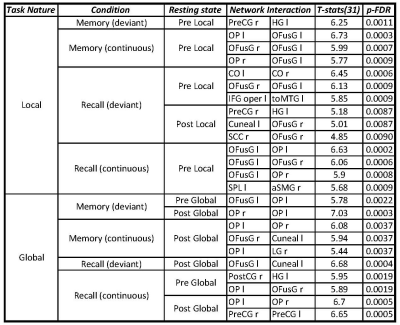3152
Dynamic nature of resting networks across different brain states in auditory attentional framework.1Department of NMR, All India Institute of Medical Sciences, New Delhi, India
Synopsis
Understanding the hemodynamic signature of experience elucidating cognition is an important feature of dynamic functional connectivity. Quantification of such dynamic microstate may play a role across neuro disorders. We employed a rest-task-rest design of Navon paradigm with auditory load to highlight the feature of dynamic networks specific to task. Quantifying perception stage of stimuli reveal dynamic interaction limited to task specific attention and information processing networks (even across resting phase) and predict dynamic nature across brain states.
Introduction
Cognition and its dynamic interplay corresponds to individual actions and processing. Underlying microstates exhibit changes in hemodynamic response, reflecting network reorganization. As cognitive task prolong temporally, the network dynamically modulate most efficient interaction to adjust consumption of oxygenation dependence during the task for effective performance 1. Mapping such dynamics may prove significant in expanding our understanding between behavioural and cognitive responses to quantify adaptive behavior 2. We investigated task specific information processing network interaction associated with dynamic nature (while at rest) in contrast to attentional load framework (specific to task).Method
An fMRI task consisting of Alphabet Navon design to study local and global processing framework incorporating continuous (scanner Noise) and deviant (Pink Noise) conditions superimposed on local and global framework was designed and carried out on healthy volunteers (n=32), after IEC approval, on a 3T MR scanner (Ingenia 3T, M/s Philips). The participants underwent two sessions of resting phase prior and post global and local task to study the dynamic characteristics. Data was processed using weighted GLM functional connectivity analysis to highlight dynamic change across resting state. Network interaction for resting modulation were computed for resting states (pre/ post task) with respect to local and global task condition of memory/recall, where auditory specific condition (deviant and continuous noise) computed for weighting with connection level threshold (p-FDR<0.001), suppressing any cluster level biases specific to individual condition.Result
Local Navon task exhibited network interaction at precentral gyrus (PreCG(r)) and Helsch gyrus (HG l) for memory (deviant), and occipital fusiform gyrus (OFusG(l)) with bilateral occipital pole (OP l/r) for memory (continuous). In global Navon task for memory(deviant), OFusG(l) with OP(l) were statistically significant with p-FDR<0.001 during pre-task condition. Also, in global task memory(continuous) condition, network interaction of OP(l) with OP(r) and lingual gyrus (LG(r)), OFusG(r) with Cuneal(l) was observed for post-task condition with significant interaction in local condition. In recall (deviant) condition, OFusG interaction with Cuneal for post rest was observed which was inter-hemispheric in local and intra for global. Additionally, recall(deviant) with respect to pre task had network interaction between Inferior Frontal Gyrus-pars opercularis (IFG oper (l)) and Middle Temporal Gyrus (MTG(l)). In recall(continuous) in local task connection between OFusG(l) with OP(l) and Superior Parietal Lobule (SPL(l)) with anterior Supramarginal Gyrus (aSMG (r)) was observed with respect to pre task state. And for recall(continuous) in global task, Postcentral Gyrus(r) with HG(l)and OP(l) with OFusG(r) in pre-rest condition and hemispheric OP and Precentral Gyrus for post-rest condition was observed.Discussion
Dynamic characteristics of brain microstates across different (Navon) task condition with auditory modulation revealed dynamic interplay between fusiform gyrus and occipital pole. As the attentional framework is loaded with auditory load, stimuli perception changes across local and global condition3. Irrespective of deviant and continuous condition, role of fusiform gyrus was observed as an information processing hub, consistent with its role in language4. Occipital pole and it’s inter and intra- hemispheric interaction (Table 1) may be attributed to visual stimuli characteristics of Navon (both local and global) task processing5. Consistent network interaction across different brain states represent dynamic nature of cognition associated with most recent experience6.Conclusion
Dynamic interaction of cognitive network is associated with recent experiences. Irrespective of cognitive condition, the active information sustainability retains similar interplay across different brain states.Acknowledgements
This work was supported by LSRB, DRDO vide grant no. LSRB-295/PEE&BS/2017.References
1. Balsamo, L. M., Xu, B., & Gaillard, W. D. (2006). Language lateralization and the role of the fusiform gyrus in semantic processing in young children. NeuroImage, 31(3), 1306–1314. https://doi.org/10.1016/j.neuroimage.2006.01.027
2. Kaiser, J., Lutzenberger, W., Decker, C., Wibral, M., & Rahm, B. (2009). Task- and performance-related modulation of domain-specific auditory short-term memory representations in the gamma-band. NeuroImage, 46(4), 1127–1136. https://doi.org/10.1016/j.neuroimage.2009.03.011
3. Lin, P., Yang, Y., Gao, J., De Pisapia, N., Ge, S., Wang, X., Zuo, C. S., Jonathan Levitt, J., & Niu, C. (2017). Dynamic Default Mode Network across Different Brain States. Scientific Reports, 7(1), 46088. https://doi.org/10.1038/srep46088
4. Schneiders, J. A., Opitz, B., Tang, H., Deng, Y., Xie, C., Li, H., & Mecklinger, A. (2012). The impact of auditory working memory training on the fronto-parietal working memory network. Frontiers in Human Neuroscience, 6, 173. https://doi.org/10.3389/fnhum.2012.00173
5. Simony, E., Honey, C. J., Chen, J., Lositsky, O., Yeshurun, Y., Wiesel, A., & Hasson, U. (2016). Dynamic reconfiguration of the default mode network during narrative comprehension. Nature Communications, 7(1), 12141. https://doi.org/10.1038/ncomms12141
6. Zhou, Q., Zhang, L., Feng, J., & Lo, C.-Y. Z. (2019). Tracking the Main States of Dynamic Functional Connectivity in Resting State. Frontiers in Neuroscience, 13. https://doi.org/10.3389/fnins.2019.00685
